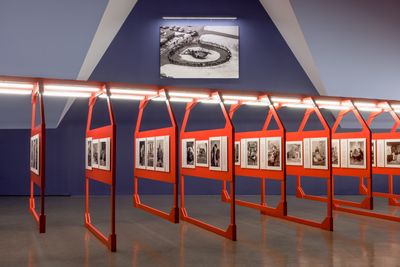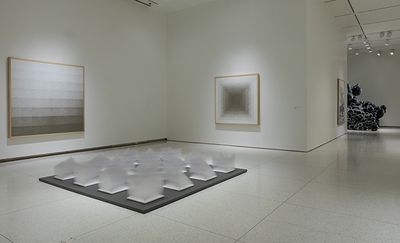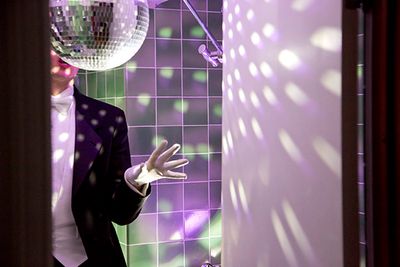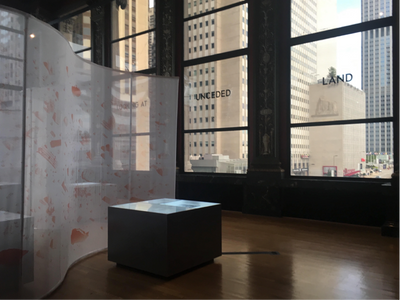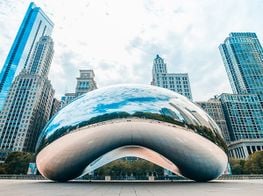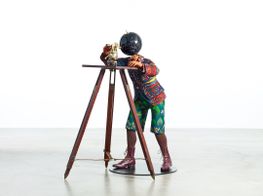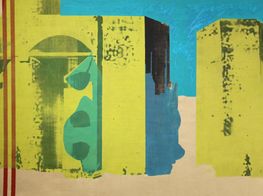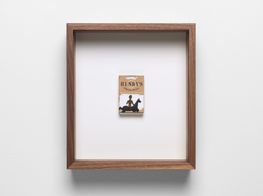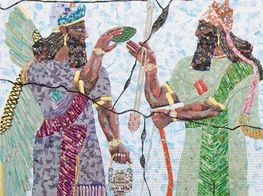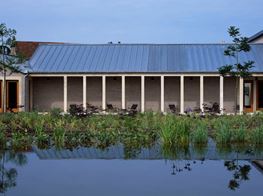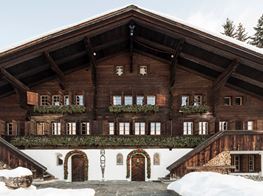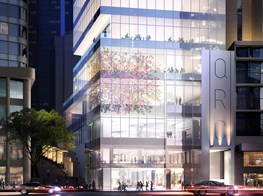EXPO Chicago Sets the Scene for 2020
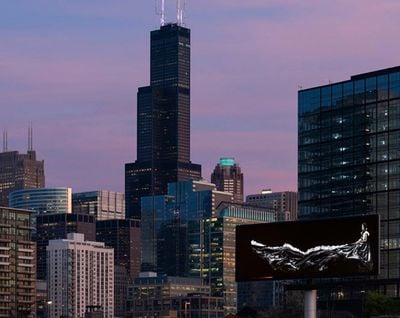
Ayana V. Jackson, Sea Lion (2019). Exhibition view: OVERRIDE | A Billboard Project, EXPO Chicago (19–22 September 2019). Courtesy Mariane Ibrahim Gallery, Chicago. Photo: Jim Prinz.
'Where Will You Be in 1933?' was the official song of the 1933 Chicago World's Fair—a buoyant ditty written in 1932 to promote an exposition celebrating Chicago's centennial during the Great Depression. On 18 September 2019, it was performed at the Chicago Symphony Center as part of Samson Young: World Fair Music. The performance extended from Young's first U.S. museum exhibition at Chicago's Smart Museum of Art, Silver Moon or Golden Star, Which Will You Buy of Me?, which opened during EXPO Art Week (16–22 September 2019), an impressive alignment of galleries, spaces, and institutions, at the centre of which is the art fair EXPO Chicago (19–22 September 2019).
Imagining what could happen in one year feels a little ominous in Chicago, which is located in the so-called Rust Belt, a focal point in the election of the current U.S. president. Trump's name is emblazoned in bold caps on the façade of his eponymous tower, in prime position on the banks of the Chicago River next to two iconic examples of the city's illustrious architectural history: Mies van der Rohe's IBM Tower and Bertrand Goldberg's Marina City. By the time EXPO Art Week kicks off next year, the U.S. presidential race will be nearing completion.
Tapping into the regional context is LaToya Ruby Frazier's show at The Renaissance Society in the University of Chicago. The Last Cruze (14 September–1 December 2019) is a new body of work documenting the lives of workers disrupted by the 'unallocation' (read: decommissioning) of a General Motors factory in the small Rust Belt town of Lordstown, Ohio; at a time when, as the exhibition curators Karsten Lund and Solveig Øvstebø note, 'the company shifts more production overseas and directs more resources toward electric and autonomous vehicles.'
An installation of large red frames lined up in a horizontal column mirrors the form of an automobile assembly line; on each, black and white portraits are shown alongside testimonies of GM employees, some of whom have been working at the plant for decades, and their families, friends, and union workers—all affected by the choice offered to them: either remain with the company and relocate to different parts of the country, or cut ties and lose pensions and benefits to stay put.
The Last Cruze is part of a cluster of shows at the University of Chicago. These include Tara Donovan's brilliant collection of minimalist sculptures and 'paintings' composed of quotidian materials like straws, metal slinkys, and index cards at the Smart Museum of Art, which shares the building with Samson Young's aforementioned solo.
Young's show comprises three video installations that explore conditions of utopia. Houses of Tomorrow (2019), for example, shows a man singing Bing Crosby's 1930s hit 'Did You Ever See A Dream Walking' inside two homes built for the 1933 Fair. As part of the installation, the face of Hu Shih, a Chinese intellectual whose lecture series at the University of Chicago was later published under the title 'The Chinese Renaissance', is projected onto a rotating half-sphere hanging from the ceiling. His likeness comes from a sculpture by Malvina Hoffman, a former student of Rodin—one of the 104 bronzes that formed the artist's Races of Mankind show at Chicago's Field Museum, which was held concurrent to the 1933 exposition.
The problematic vestiges of colonial histories are visible around Chicago. At the DuSable Bridge, named after the Afro-Haitian founder of the original settlement, a sculptural relief on one of the bridge's main columns depicts a colonial soldier in battle with an indigenous American, as an angel flies overhead—the inscription commemorates 'martyrs' who were 'massacred' by 'the Indians' in 1812.
But efforts are being made to recuperate and rectify tainted and white-washed pasts. As part of the Oriental Institute's centennial year, artists Michael Rakowitz and Mohamed Hafez were invited to intervene in the Institute's impressive display of artefacts, including a colossal limestone bullhead that once guarded the Hundred-Column Hall at Persepolis. Hafez, the Institute's first 'interpreter-in-residence' is showing architectural models based on memories of Damascus, while Rakowitz created a relief out of Arabic newspaper clippings and packaging to surround (and complete) a relief fragment of an Assyrian king's head from the museum's collection—part of 'The invisible enemy should not exist' series, which recreates artefacts stolen or destroyed since the invasion of Iraq in 2003.
Decolonisation continues at the 3rd Chicago Architecture Biennial, . . . and other such stories (19 September 2019–5 January 2020), which begins at the Chicago Cultural Center with a wall text communicating a land acknowledgement recognising the Council of the Three Fires—the Odawa, Ojibwe, and Potawatomi Nations—as the land's traditional custodians. Part of Mapping Chicagou/Chicago: A Living Atlas by the Settler Colonial City Project, information boards identify markers of exploitation embedded into the architecture around the venue. In one hall, the words 'YOU ARE LOOKING AT UNCEDED LAND' are pasted onto the windows.
Organised by artistic director Yesomi Umolu with curators Sepake Angiama and Paulo Tavares, . . . and other such stories explores alternative economies, common-ing infrastructures, and modes of resistance. FICA's installation What Does an Ethical Landlord Look Like? (2019) is about a crowd-funded real estate fund responding to São Paulo's housing crisis by devising ethical structures to acquire property to rent out at below-market prices. Theaster Gates' contribution documents the artist's work in restoring and reclaiming houses on Chicago's South Side, launching the Rebuild Foundation in 2009, and opening the Stony Island Arts Bank in 2015.
Currently on view at Stony Island Arts Bank is group show In The Absence of Light: Gesture, Humor and Resistance in The Black Aesthetic (19 September–29 December 2019), which draws from the Beth Rudin DeWoody Collection. Works include paintings by Toyin Ojih Odutola, Henry Taylor, and Lynette Yiadom-Boakye, and a large hanging trench coat filled with an elaborate mesh of watches, chains, and metal costume jewellery by Nick Cave (Hustle Coat, 2014).
Gates describes this joint venture as 'a point of mutuality' between 'collaborators and colleagues' rather than 'givers and takers'—an attitude that sums up what EXPO Chicago president and director Tony Karman described as 'the Chicago way' during a reception at the Museum of Contemporary Art Chicago. Here, Virgil Abloh's current exhibition Figures of Speech—a playful and incisive showcase celebrating the breadth of this multi-disciplinary artist and designer's practice—has become the museum's best-attended exhibition to date. (One exhibit involves a 2018 cease and desist letter from the U.N. asking Abloh to stop using the organisation's logo on his Flat White DJ party flyers.)
In short, cooperation makes Chicago's art scene tick, apparently—as communicated by the integrated programming that unfolded during its art fair week, from the 45th Anniversary show at the non-profit Chicago Artists Coalition, to Art on theMART, a programme of projections on the downtown Merchandise Mart building. With that in mind, it is hard to experience EXPO Chicago in isolation from what surrounds it, from the three-winged Lake Point Tower that inspired the Burj Khalifa, whose architect is behind Chicago's Trump Tower; to the Art Institute of Chicago's brilliant collection.
Among the city-based galleries, shows ranged from Crossing The Rainbow Bridge at Carrie Secrist Gallery (14 September–26 October 2019), Adrian Wong's paean to pets and their dreams; Yankee Go Home at Andrew Rafacz Gallery (19 September–25 October 2019), Sheida Soleimani's bright, pop-infused photographic still life compositions referencing U.S. oil exploits in Iran and Iraq; and Take Me to the Water at Mariane Ibrahim Gallery (20 September–26 October 2019), Ayana V. Jackson's photographic self-portraits inspired by Detroit techno and African water spirits, which inaugurated the gallery's new space. Jackson also participated in EXPO Chicago's public art project OVERRIDE, with artists like Shezad Dawood and Betty Tompkins screening artworks on billboards.
As a whole, EXPO Art Week highlights a drive for Chicago's cultural scene to capitalise on and deconstruct its legacy as a world city on multiple fronts, so as to make space for new futures. At the Richard H. Driehaus Museum, for example, Yinka Shonibare inaugurated its contemporary art series with a solo show A Tale of Today (2 March–29 September 2019), placing headless figures dressed in Victorian clothes made from Dutch wax fabrics in various rooms of this ornate and opulent 19th-century Gilded Age Nickerson Mansion. A smaller show is dedicated to four artists enrolled in the Emerging Artists Fellowship: Darrell McKinney, Jeffly Gabriela Molina, Luis Rodríguez Rosario and Brittney Leanne Williams. Led by curatorial fellow Kekeli Sumah, this pilot programme aims to open the museum up to new generations.
The art fair around which all this activity orbits—and to which this art-filled week is anchored—is likewise mediating cross-hatching registers, be they historical, emergent, regional, or global. This year, the 8th EXPO Chicago welcomed 135 galleries from 24 cities and 68 cities, among them newcomers including Hauser & Wirth and Galerie Thaddaeus Ropac, with artistic director Stephanie Cristello driving programming that includes the Dialogues talks series organised in collaboration with the School of the Art Institute of Chicago, and the Curatorial Forum held in partnership with Independent Curators International (ICI).
While some visitors observed a shift from an overtly political fair floor in 2018, works were not lacklustre or disconnected. Brightly coloured paintings by Peter Williams at Luis De Jesus Los Angeles in the main sector included We travelled to distant worlds (2019), a large oil on canvas landscape of a red-sky planet annotated with the names of revolutionary historical figures like Frantz Fanon and Prince, while Mendes Wood DM gave centre stage to a large, floor sculpture of an abstracted Martin Luther King by Paul Nazareth (Dry Cut [from Blacks in the Pool – Martin], 2019).
Georgia Scherman Projects, showing in the Profile sector, brought a trio of sculptures by Esmaa Mohamoud that explore the intersection of race and sport, including football shoulder pads augmented with chains cascading down the back to form a cape paired with headgear upholstered with matching fabric. In the Exposure sector, Nome Gallery focused on Xerox collages by Kameelah Janan Rasheed—scans in which texts on equations have been cut and pasted to form phrases like 'There is nothing revolutionary about approximations'. The artist was awarded the Northern Trust Prize, with four works donated to the Speed Art Museum in Louisville, Kentucky.
Political leaders popped up in various booths. Trump was spotted among the shadow puppets by Spyros Aggelopoulos lining the back wall of Dio Horia's booth, representing characters from pop culture and real life, from Homer Simpson and Freddie Kruger to Larry King, while Galerie Ernst Hilger hung a weird 1975 portrayal of a young Chairman Mao emerging from behind a line of identical red-heads by Erró.
In the Editions and Books sector, the Brodsky Center at the Pennsylvania Academy of the Fine Arts showed Benjamin Patterson's portfolio of digital prints, My Thirteen Presidents (2009): an illustrated profile of 13 American leaders according to their astrology signs and the deeds of their tenure, from Roosevelt (an Aquarius) to Obama (a Leo).
More political figures were seen at the Special Exhibitions sector, dedicated to non-profit organisations, institutions, and museums, and where Human Rights Watch participated in 2019 for the sixth year running.
Garage Museum of Contemporary Art's display, presented in collaboration with the fair and the Natural Resources Defense Council, was based on the museum's current show in Moscow, The Coming World: Ecology as the New Politics 2030–2100 (28 June–1 December 2019). Smog Collectors (2019) by Kim Abeles comprises ten porcelain plates with the face of a world leader, including Angela Merkel and Dilma Rousseff, and their statements on the environment. Each dish was made by placing a stencil on the surface and leaving it outside to collect Moscow smog—a horrific reminder of the certainty with which the earth is being destroyed given the lack of political will to face the problem.
Over at Chicago Invitational, staged at the Chicago Athletic Association Hotel by the New Art Dealer's Alliance, the faces of key global players—from Mohammed bin Salman and Kim Jong Un, to Xi Jinping and Vladimir Putin—lined one wall of Dubai gallery Carbon 12's booth in a set of six 2019 oil paintings by Amir Khojasteh. Each is rendered in thick and furious expressionist strokes; scant features barely masking recognisable visages. Their presence recalled the question posed by that Chicago World's Fair song nearly a century ago: where will they be, and by association where will the world be, one year from now? —[O]

